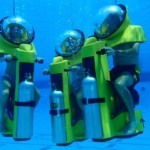Sunday evening the intelligent and lovely Sheril Kirshenbaum posited a question that I have received many times. The question is always a good one because it stems from knowledge and deductive reasoning. The said question requires one to know that one of the most extreme environmental gradients is the increase of pressure with increasing depth, at the surface being 1 atm and reaching well over 1,000 atm in deepest parts of the ocean. The question(s) how do organisms survive this great pressure and what happens to organisms when you bring them to the surface? I really never get tired of answering this question. I have addressed this question before…
“What about the pressure!” Pressure doesn’t kill deep-sea organisms crack temperature does. Several studies indicate the deep-sea organisms can withstand a wide range of pressures. We frequently capture organisms at depth and bring them to surface alive. They either live in aquarium in the laboratory or even shipped across the country alive. Some pelagic organisms also have amazing vertical migrations during the course of 24 hours that can encompass 1000’s of meters. Warm temperature on the other hand is bad. On trips to the Equatorial Pacific, organisms are rarely brought back to the surface alive. We ensure we keep deep-sea organisms in aquaria at 4 degrees Celsius.
We have also discussed why fish don’t crush and the biochemical adaptations related to pressure.
A new study on marine genomics at the wonderfully, open access journal PLoS One (thanks to people like Bora) sheds some insights to importance of temperature, and not pressure, in stratifying microbial communities, in both ecological and evolutionary timescales, of deep-sea systems. Unsurprisingly, most studies center on microbial communities of the photic zone. The current study deals with Mediterranean microbes from 3,000m. Key to remember is that the deep Mediterranean is significantly warmer to other deep-sea regions. At about 12-15 degrees C, it is warm bath compared to the 2-4 degree C that characterized the rest of the deep oceans.
Martin-Cuadrado and colleagues develop a genomic library based 16S rRNA, a complicated way of saying they developed a dataset of ribosomal gene sequences for multiple species, in this case bacteria, archaebacteria, and the such. Using these sequences, and comparing to known sequences, one can simply create a faunal list. Comparing to this dataset to a genomic library from the ALOHA site in the Pacific, they found that the community of microbes from 3,000m in the Meditterrean was more similar to a 600m, opposed to a 4000m deep, sample from ALOHA. This suggests that temperature is a more important structuring agent than pressure, otherwise the 3000m and 4000m samples would be similar. Other interesting findings include the observation of the presence of several genes, allowing the for ability to degrade complex organic molecules vital to success in a food-limited system like the deep oceans. More importantly, is the observation of several genes that allow bacteria oxidize carbon monoxide as another potential energy/carbon source.
Overall a great paper that is publicly available because PLoS is open access. You can also keep track of more aspects of the paper here.






Craig,
Glad you liked the paper and thanks for linking to it but better to use our new trackback links (like this one) so more people can see that you blogged about it.